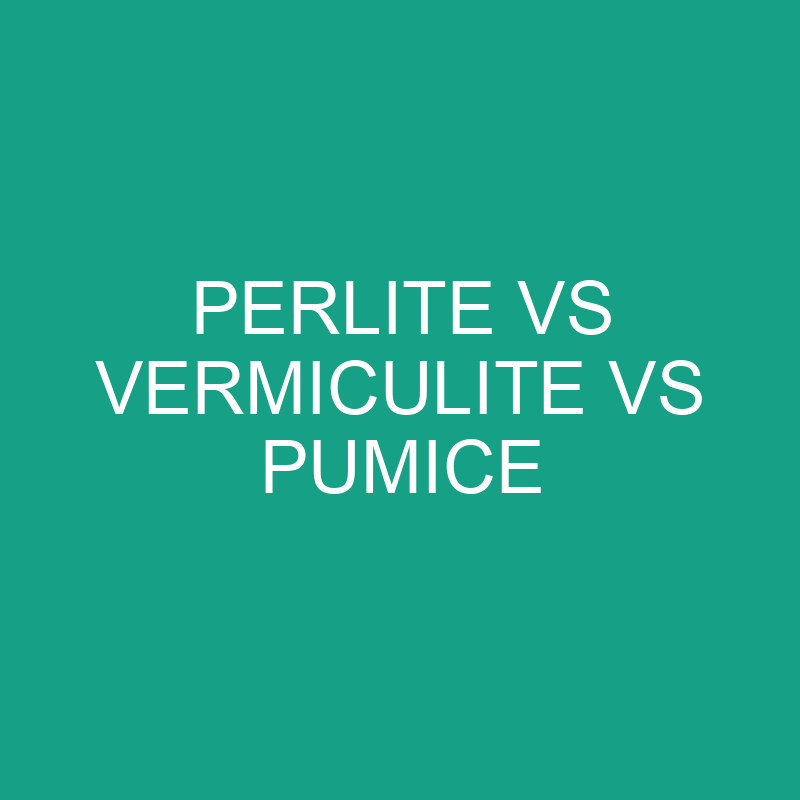Perlite, vermiculite, and pumice are all types of mineral-based soil amendments that are commonly used in gardening and horticulture to improve soil structure, drainage, and aeration. While they may appear similar, they have unique properties that make them suitable for different applications. In this article, we will explore the differences between perlite, vermiculite, and pumice.
Post Contents
What is Perlite?
Perlite is a volcanic mineral that is processed into a lightweight, white, granular material. It is produced by heating raw perlite ore to a high temperature, causing it to expand and form small, air-filled cavities.
Perlite is commonly used in potting soils and soilless mixes to improve drainage and aeration, as it has a neutral pH and does not decompose over time. Perlite can also be used to start seedlings, as it provides good moisture retention while still allowing for oxygen exchange.
What is Vermiculite?
Vermiculite is also a mineral-based soil amendment that is made from micaceous minerals that are heated to high temperatures. The heat causes the minerals to expand, forming a lightweight, spongy material with high water-holding capacity.
Vermiculite is commonly used in potting soils to improve moisture retention and aeration, as it holds water like a sponge and slowly releases it back to the plant. Vermiculite is also often used as a seed-starting medium, as it is sterile and can help prevent damping-off disease.
What is Pumice?
Pumice is a volcanic rock that is formed when lava cools rapidly and traps gas bubbles inside. The resulting material is a lightweight, porous rock that is often used in soil mixes to improve drainage and aeration.
Pumice is ideal for use in cactus and succulent soils, as these plants require excellent drainage and do not like to sit in wet soil. Pumice is also used in hydroponics, as it can hold moisture and nutrients while still allowing for good aeration.
Perlite Vs Vermiculite Vs Pumice Pros and Cons
Perlite, vermiculite, and pumice are all commonly used in horticulture as soil amendments to improve soil structure, drainage, and aeration. While they have some similarities, each has its own unique properties and benefits. In this article, we will explore the pros and cons of perlite, vermiculite, and pumice.
Perlite:
Pros:
- Lightweight and easy to handle
- Provides excellent drainage and aeration
- Does not break down or decompose over time
- Neutral pH and sterile, making it ideal for starting seedlings
Cons:
- Can be dusty, which can irritate the respiratory system
- Can float to the top of the soil over time, especially if the soil is watered heavily
- Can be difficult to wet if it dries out completely
Vermiculite:
Pros:
- Retains moisture well, making it ideal for plants that need consistent moisture
- Improves soil aeration and drainage
- Neutral pH and sterile, making it ideal for starting seedlings
- Can help prevent damping-off disease in seedlings
Cons:
- Can become compacted over time, reducing aeration and drainage
- May break down over time and become mushy if overwatered
- Can retain too much moisture if used in excessive amounts
Pumice:
Pros:
- Provides excellent drainage and aeration
- Resists compaction and does not break down over time
- Lightweight and easy to handle
- Neutral pH and does not contain any nutrients, making it ideal for mixing with other soil amendments
Cons:
- Can be difficult to find in some areas
- Can be too porous for plants that require consistent moisture
- May need to be rinsed or pre-soaked to remove any fine particles or dust
Comparison Table:
| Perlite | Vermiculite | Pumice |
|---|---|---|
| Lightweight and easy to handle | Retains moisture well | Provides excellent drainage and aeration |
| Provides excellent drainage and aeration | Improves soil aeration and drainage | Resists compaction and does not break down over time |
| Does not break down or decompose over time | Neutral pH and sterile | Lightweight and easy to handle |
| Neutral pH and sterile | Can help prevent damping-off disease | Neutral pH and does not contain any nutrients |
| Can be dusty | Can become compacted over time | Can be difficult to find in some areas |
| Can float to the top of the soil over time | Can retain too much moisture if used in excessive amounts | Can be too porous for some plants |
| Can be difficult to wet if it dries out completely | May break down over time and become mushy if overwatered | May need to be rinsed or pre-soaked to remove fine particles or dust |
Summary
In conclusion, perlite, vermiculite, and pumice are all useful soil amendments with unique properties and benefits. Perlite is best for improving drainage and aeration, vermiculite is best for retaining moisture, and pumice is best for providing excellent drainage and aeration while resisting compaction. Understanding the pros and cons of these materials can help gardeners and horticulturists select the best soil amendment for their specific needs.
